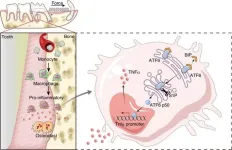(Press-News.org) Prescribed burns literally fight fire with more fire. Often referred to as a “beneficial fire,” they target areas at risk for wildfires and burn away material that could otherwise fuel a future blaze.
However, all fires, whether accidental or planned, produce smoke that can cause health and respiratory issues, especially in nearby communities. Burning fires release harmful chemicals, like polycyclic aromatic hydrocarbons (PAHs), that are carcinogenic – PAHs can cause cancer, lung damage, and lead to weakened immunity in those who inhale smoke.
Recently, in a study published in Atmospheric Pollution Research, scientists at Stanford University suggested ways to perform prescribed burns with drastically reduced health implications. They’ve determined that simply tweaking some of the burn conditions can slash PAH emissions by up to 77%. The researchers estimate that this could cut cancer risks from smoke exposure by over 50%.
“There is clearly potential for improving prescribed burn procedures, such that the health impact is reduced,” said Karl Töpperwien, lead author of the paper and postdoctoral fellow in the Department of Mechanical Engineering in the School of Engineering. “We can essentially kill two birds with one stone – protect ecosystems while simultaneously protecting communities that would be otherwise at risk.”
Many hands make light work
To bring this new method to fruition, Töpperwien’s team took a multidisciplinary approach, collaborating with medical researchers at the Harvard T.H. Chan School of Public Health, physicists at the SLAC National Accelerator Laboratory, and chemical researchers at Aerodyne Research Inc.
The medical researchers identified the most toxic pollutants from wildfires, in terms of potential harm to humans. Many PAHs are listed as carcinogenic pollutants by the U.S. Environmental Protection Agency (EPA) and can cause long-term health impacts. “We were focusing on these as our priority pollutants because exposure to these pollutants can cause cancer, inflammation, and other types of diseases,” said Töpperwien.
Once identified, the next obstacle was how to measure these pollutants precisely. This is where the chemists brought in their expertise. “They are excellent experimentalists who really advanced the frontier of measuring chemical species at high selectivity and precision,” said Matthias Ihme, senior author of the paper and professor of mechanical engineering in the School of Engineering and of photon science at SLAC National Accelerator Laboratory.
Töpperwien and Ihme’s team tied their collaborative efforts together by building the experimental apparatus that enabled these measurements and providing expertise on the fundamentals of fire behavior. They built a laboratory-sized combustion chamber where they burned samples of Eastern White Pine, one of the most common trees found on the eastern U.S with the highest emissions of PAHs among commonly studied hardwoods and softwoods.
Fine-tuning fires
Adjusting the moisture, heat, and oxygen level of the fires, the researchers conducted controlled burn experiments in their lab. They used high-resolution atmospheric and aerosol mass spectrometers to measure gaseous PAH emissions and particle-phase aerosols in real time.
Their experiments revealed that fine-tuning three conditions can reduce PAH emissions by up to 77%.
The first condition concerns the moisture content of the fuel. They found that the wood should have a moisture content of 20-30% – too dry and it burns too fast, producing more smoke, but too wet and it smolders, emitting high levels of PAH. Second, the heat intensity of the fire needs to be between 60-70 kW/m². Different levels of heat load promote different chemical reactions, which ultimately form PAHs: dialing in the heat means finding the “sweet spot” where the least PAH is formed. Finally, the fires need to burn with oxygen levels of 5-15%. Too little oxygen can cause inefficient burns, leading to too much smoke, while too much oxygen can make a fire burn uncontrollably.
These three burn parameters can effectively make prescribed burns safer and cleaner for the environment and for communities living near fire-prone regions.
Fire in the field
Ultimately, the question is whether these laboratory fires can be replicated in real-life prescribed burns. The researchers believe it to be highly possible and note that many of the techniques that could control these conditions are already used in field tests. “There will be some limitations to upscaling this, but I clearly see a path towards making this technique more viable for a broader range of environmental conditions,” said Ihme, who is also a principal investigator with the Stanford PULSE Institute at SLAC.
In fact, Töpperwien remarks that forest managers and burn crews often prepare the wood by pre-burn treatments such as chopping, drying, and measuring moisture content to increase burn efficiency. Moisture content is perhaps the most straightforward parameter to control. Oxygen level and fire intensity are affected by the size of the wood burned and the arrangement of the burn pile, but it will take further research to understand how to precisely influence those parameters in a real-world burn.
For the team, the next steps include replicating the laboratory burns in a field experiment and observing how their findings translate to real-life prescribed burns. The researchers will also expand this work by experimenting on different woods and by finding the best balance between cleaner burns, fuel consumption, and the cost of employing these methods.
“Fire is more complex than we think,” said Ihme. “It’s not only finding where the flame is, but also how the smoke is transported, how it affects long-term health, and how it is admitted into the environment as it settles from the air onto the soil.”
For more information
Additional Stanford co-authors of this work include postdoctoral scholar Guillaume Vignat, former postdoctoral scholar Alexandra Feinberg, and Matthias Kling, professor of photon science at Stanford and SLAC. Additional co-authors are from Aerodyne Research Inc. and Harvard T.H. Chan School of Public Health.
This research was funded by the Stanford Sustainability Accelerator, the Google Academic Research Awards program, the Moore Foundation, and the U.S. Department of Energy.
END
New study reveals how to make prescribed forest fires burn safer and cleaner
2025-04-15
ELSE PRESS RELEASES FROM THIS DATE:
Inactive components in agricultural runoff may be hidden contributors to drinking water hazards
2025-04-15
Inactive ingredients in agricultural, pharmaceutical and other common products have typically been excluded from consideration as potential contaminants in drinking water. However, while these chemicals are inert in certain products, they still can pose hazards when combined with other materials during the drinking water treatment process.
A new study from researchers in the McKelvey School of Engineering at Washington University in St. Louis reveals how large this impact might be. Jean Brownell, a graduate student working with Kimberly Parker, associate professor of energy, environmental & chemical engineering, ...
Colombia’s peatlands could be a crucial tool to fight climate change. But first we have to find them
2025-04-15
UC Santa Cruz Assistant Professor of Environmental Studies Scott Winton has been wading through thick, smelly muck in the tropics for almost a decade. He wouldn’t have it any other way. As a wetland ecologist and biogeochemist, he’s been hard at work investigating an important and mysterious topic: peatlands.
Peatlands are a special type of wetland with enormous potential to either help or hurt global efforts to address climate change. If we want peatlands on our side, we’ll have to protect them. But that’s difficult to do, since we still don’t ...
Researchers refine a hybrid music therapy intervention for patients with cardiac and pulmonary conditions
2025-04-15
CLEVELAND – A new study from University Hospitals Connor Whole Health found that it was feasible to conduct a hybrid music therapy intervention for patients with heart failure and patients with chronic obstructive pulmonary disease (COPD). Participants reported positive effects on their mental health, and the pilot uncovered solutions to improve future research with this population. The findings from this study were recently published in BMC Complementary Medicine and Therapies.
Patients with chronic illnesses such as heart failure and COPD face significant challenges due ...
Research Spotlight: Combining dexmedetomidine with spinal anesthesia prolongs pain relief and decreases shivering during surgery
2025-04-15
Heitor Medeiros, MD, and A. Sassan Sabouri, MD, of the Department of Anesthesia, Critical Care and Pain Medicine at Massachusetts General Hospital, are the lead and corresponding authors, respectively, of a paper published in the British Journal of Anaesthesia (BJA).
How would you summarize your study?
Spinal anesthesia is widely used to numb patients during surgery, but its effects sometimes wear off too soon. Many anesthetists have experimented with adding extra drugs to extend pain relief. Dexmedetomidine demonstrated results in multiple randomized clinical trials suggesting it could prolong numbness ...
Pennington Biomedical’s 2025 Bray Obesity Symposium to offer on-demand continuing education for physicians
2025-04-15
FOR IMMEDIATE RELEASE
April 15, 2025
BATON ROUGE – The 2025 Bray Obesity Symposium welcomes all health physicians and researchers interested in the latest in metabolic health to register for the on-demand online offerings. The online-only content is available to access upon registration, and the symposium has been designated by the American Board of Obesity Medicine, or ABOM, as a Group One Primary Medicine Continuing Medical Education partner.
The symposium is an intensive Board Review Course in preparation for the ABOM’s certification exam, including materials ...
Unlocking faster orthodontic treatments: the role of atf6 in bone remodeling
2025-04-15
Orthodontic treatments often take years, but a breakthrough discovery could drastically shorten this period. Researchers have uncovered that ATF6, a protein activated in macrophages during corticotomy, accelerates tooth movement by promoting inflammation and boosting the production of TNFα, a key factor in bone remodeling. This finding paves the way for faster, more efficient orthodontic procedures, minimizing both treatment time and patient discomfort. The study highlights the potential for non-invasive therapies that could reshape the future of orthodontic care.
Corticotomy, a surgical procedure aimed at accelerating tooth movement, ...
SwRI-led Lucy mission survey of main belt asteroid Donaldjohanson imminent
2025-04-15
SAN ANTONIO — April 15, 2025 —The Southwest Research Institute-led Lucy mission is preparing to survey the next target in its epic 4-billion-mile, 12-year, 11-asteroid tour. On April 20, 2025, NASA’s Lucy spacecraft will fly past the three-mile-wide main belt asteroid (52246) Donaldjohanson as a test run to the main event: visiting the never-before-explored Trojan asteroids in the Jupiter system.
For billions of years, these mysterious space rocks have been gravitationally trapped in two swarms leading and trailing Jupiter in orbit around the Sun, holding clues to the formation of our solar system. NASA’s Lucy spacecraft will be the ...
New bat cell lines and reagents help to study bat antiviral immune responses against hantaviruses and coronaviruses
2025-04-15
New bat cell lines and reagents help to study bat antiviral immune responses against hantaviruses and coronaviruses
In your coverage, please use this URL to provide access to the freely available paper in PLOS Biology: https://plos.io/3E5BYAJ
Article title: Expanding the bat toolbox: Carollia perspicillata bat cell lines and reagents enable the characterization of viral susceptibility and innate immune responses
Author countries: Canada, United States
Funding: see manuscript END ...
Preterm birth might be predicted with high accuracy with new cheap, non-invasive test, based on cell-free DNA collected in standard early pregnancy testing
2025-04-15
In your coverage, please use this URL to provide access to the freely available paper in PLOS Medicine: https://plos.io/3RuCJ9v
Article title: Genome-wide nucleosome footprints of plasma cfDNA predict preterm birth: A case-control study
Author countries: China, United Kingdom
Funding: This work was supported by project grants from the National Natural Science Foundation of China [81600404 to JT, 82270600 to JT, 81871177 to FY, 82271711 to XY, 82173001 to ZG]; Guangdong Basic and Applied Basic Research Foundation [2022A1515220204 to JT; 2024A1515012792 to ZG]; Guangzhou Key Laboratory ...
CVD researcher/clinician named editor-in-chief of Circulation: Genomic and Precision Medicine.
2025-04-15
DALLAS, April 15, 2025 — Ferhaan Ahmad, M.D., Ph.D., FAHA, is the new editor-in-chief of Circulation: Genomic and Precision Medicine, a peer-reviewed scientific journal published by the American Heart Association, effective with the journal’s April issue, published today. Ahmad is the founding director of the Cardiovascular Genomics Program and associate professor of internal medicine-cardiovascular medicine at the University of Iowa Carver College of Medicine in Iowa City, Iowa. He takes the helm leading Circulation: Genomic and Precision Medicine from Kiran Musunuru, M.D., Ph.D., M.P.H, FAHA, who served as interim editor-in-chief ...




